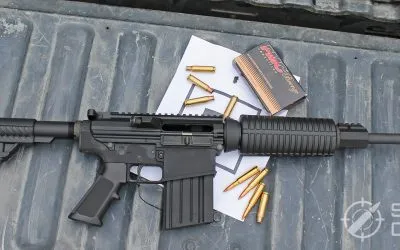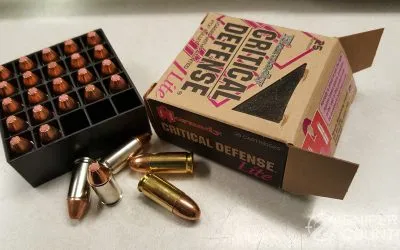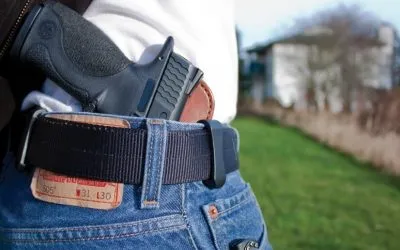
The .357 Sig
The .357 Sig (so named by SAAMI, or .357 SIG by SAAMI’s international counterpart, the C.I.P.) is a product of a business partnership between SIG-Sauer and the Federal Cartridge company. Introduced in 1994, the .357 Sig was the first bottleneck cartridge to be introduced since the 1960s. It is based on a .40 S&W case necked down to accept .355 (9mm) caliber bullets. The idea of necking down a pistol cartridge case to accept a smaller-diameter bullet is not new. Several other bottleneck-case cartridges have been introduced before or after the .357 Sig, including the .400 Corbon in 1996 and the .256 Winchester Magnum in 1960 to name a couple. The .357 Sig has garnered attention as an accurate, hard-hitting round. Law enforcement and savvy concealed-carriers who carry it are impressed by its ballistics. Here’s the SAAMI diagram of the cartridge... notice the bullet diameter is .355, not .357, as its name would imply.BONUS OFFER: Get your free shooting range targets to print at home!
Get your free targets to print at home!
Why The .357 Sig?
One of the main reasons the .357 Sig was developed was to duplicate the velocity of a 125-grain .357 Magnum bullet but out of a 4-inch autoloader’s barrel. The 125-grain .357 Magnum load was renowned on the street for its ability to stop threats with very few shots, so the powers-that-be wanted this same stopping power in an autoloader with its attendant greater ammo capacity This was accomplished with the introduction of the .357 Sig. The Texas Department of Public Safety issued, in 1996, the SIG Sauer P226 in .357 Sig to its officers. This was the first implementation of this cartridge by a government agency that I could find. After a swing back to 9mm handguns for a short time, the Texas DPS suspended the re-introduction of those 9mms after some reliability issues cropped up. At that point, they went back to the .357 Sig. To the best of my knowledge, the Secret Service, Federal Air Marshals and at least 26 police or other government agencies issue either a Sig or Glock pistol chambered in .357 Sig. That number fluctuates, but suffice it to say that these agencies are sold on the stopping power inherent in this round, with the proper ammunition. I’d read of an officer’s report that stated that, when shot with the .357 Sig, large, vicious dogs would go down with one shot as opposed to needing multiple rounds of 9mm 147-grain ammo. Even though it isn’t a person being shot, the idea is the same...stop the threat as quickly as possible. You get the idea...it is an effective round, or else all those police departments wouldn’t issue it. OK, now we’ve seen where the .357 Sig came from...let’s look at the gun on hand that fires it...the Glock Model 32.Popular Articles
The Glock 32
 The Glock 32 is a compact package that ably delivers it .357 Sig payload. The one I shot came with three 10-round magazines instead of 13-rounders, but was otherwise as stock as the day it came out of the box. That was fine with me – the gun shot very well.
Let’s look at some specifications, from Glocks’ website and my observations ...
The Glock 32 is a compact package that ably delivers it .357 Sig payload. The one I shot came with three 10-round magazines instead of 13-rounders, but was otherwise as stock as the day it came out of the box. That was fine with me – the gun shot very well.
Let’s look at some specifications, from Glocks’ website and my observations ...
| Overall length: | 7.36 inches |
|---|---|
| Width: | 1.26 inches |
| Height: | 5.04 inches (with flat magazine floorplate unlike that pictured above) |
| Barrel: | 4.02 inches |
| Magazine Capacity: | 13, 14, 15 or 16. As stated, the one I shot had 10-round mags included |
| Weight: | 24.34 ounces (with empty mag) |
| Trigger: | Glock Safe Action, 5 pound, 9.9-ounce pull (based on an average of 10 pulls measured with my Lyman pull gauge) |






Conversions
Here’s something that may appeal to you... if you already own say, a Glock 23 in .40 S&W, you can buy an aftermarket barrel in .357 Sig and essentially have two guns based on one frame. I checked some prices, and for around $140 you can get a barrel in .357 Sig and capitalize on your shooting experiences. Your .40 magazine might even work, since the .357 Sig is based on a necked-down .40 S&W case. Even some 10mm guns are candidates for conversion, since that cartridge is based on a lengthened .40 S&W. You may have to buy a new magazine...those of you with direct experience with this, please comment below. If you own a proper host-caliber gun, the addition of a .357 Sig conversion barrel allows you to expand your caliber inventory at minimal cost.BONUS OFFER: Get your free shooting range targets to print at home!
Get your free targets to print at home!
Shooting The Glock 32
Shooting any compact Glock is an experience, especially if it’s chambered for a thumping cartridge. I owned a Model 30 once upon a time – this is the compact .45 ACP. It had noticeable recoil, but was manageable and pretty easy to shoot. With my target-level handloads, it was a pussycat. This gun, not so much. Those of you who own a 32 would probably agree with me that the level of recoil is about as much as you want in a smaller gun. Mind you, I’m not saying that the gun is a fire-breather – far from it – but it does let you know when you pull the trigger. If all you’ve shot are 9mm Glocks, then this one would at least get your attention when you fired it. I ran a couple of figures through a recoil energy calculator and came up with a very rough estimation of recoil energy for the Model 32 with the 125-grain bullet. That number was 9.1 pounds...not too bad, but bear in mind my .243 Savage rifle shares that same level of recoil energy. I ran the 115-grain 9mm load and came up with an approximate 4.4 pounds of recoil energy. (By way of comparison, my old .45 ACP load generated 7.8). So, we see that the .357 Sig speaks with authority at both ends. I do want to emphasize, however, that the gun is eminently controllable – all those law enforcement agencies alluded to above would not use it if they couldn’t train their people to shoot it accurately. That’s the beauty of a lighter (125-grain) bullet moving at a faster speed – 1300 or so f.p.s. A heavier bullet at anywhere near that speed would be harder to control for follow-up shots...I refer to my experience with the Model 30 .45 ACP’s 230-grain bullet. At only 800-850 f.p.s., it could still kick a fair amount. I would not care to shoot it at anywhere near 1000 f.p.s. or more if that were possible or prudent, which it wasn’t (at least for me). Anyway, the .357 Sig exhibits a great balance of power and allows fast follow-up shots. But, is it accurate?The Target
Here is a representative target I shot with the Model 32. I shot this from a barricade position, using the barricade wall as a support for my shooting hand. I figured that, since this gun was designed for concealed carry/law enforcement, I didn’t want to shoot it off a bench but wanted a more authentic experience with it. I shot this ammo... ...which Glen said was older but still represented what the .357 Sig was capable of. He provided the ammo, which was nice of him. The box wasn’t full, so the gun had been shot. I chronographed this load, and came up with 1340 f.p.s., which delivers right at 500 foot/pounds of energy. In my state, that would be enough to hunt deer with. Self-defense loads will be in that velocity ballpark, maybe a touch faster, but by shooting this load you get a definite feel for how the G32 stacks up in the recoil and accuracy department. It also makes a good practice load for those who carry the .357 Sig. And, at the time he bought it, it wasn’t overly expensive...the price sticker was still on it and it said $16.95. Not too bad.
Here’s a sample target...
...which Glen said was older but still represented what the .357 Sig was capable of. He provided the ammo, which was nice of him. The box wasn’t full, so the gun had been shot. I chronographed this load, and came up with 1340 f.p.s., which delivers right at 500 foot/pounds of energy. In my state, that would be enough to hunt deer with. Self-defense loads will be in that velocity ballpark, maybe a touch faster, but by shooting this load you get a definite feel for how the G32 stacks up in the recoil and accuracy department. It also makes a good practice load for those who carry the .357 Sig. And, at the time he bought it, it wasn’t overly expensive...the price sticker was still on it and it said $16.95. Not too bad.
Here’s a sample target...
 Shooting from the barricade, it did better each time than it had a right to, with me behind it as I’m not the world’s greatest shot. This particular target was shot at a distance of about 10-12 yards, at my backyard range. The gun’s sights were regulated very well with this particular load, and there’s no reason to think it wouldn’t do at least as well with other .357 Sig ammo.
Having already mentioned recoil, I can see why law enforcement agencies like this cartridge. It does kick, but you can still get several rounds out of the gun before recoil becomes an issue. If you can shoot and control 9mm or .40 S&W self-defense loads, you can control this one.
Shooting from the barricade, it did better each time than it had a right to, with me behind it as I’m not the world’s greatest shot. This particular target was shot at a distance of about 10-12 yards, at my backyard range. The gun’s sights were regulated very well with this particular load, and there’s no reason to think it wouldn’t do at least as well with other .357 Sig ammo.
Having already mentioned recoil, I can see why law enforcement agencies like this cartridge. It does kick, but you can still get several rounds out of the gun before recoil becomes an issue. If you can shoot and control 9mm or .40 S&W self-defense loads, you can control this one.










![9mm Glock Models [Ultimate Guide]](https://snipercountry.com/wp-content/uploads/2018/10/Glock-17-vs-Glock-19-vs-Glock-26-vs-Glock-41-vs-Glock-43-WM-400x250.webp)
![Handgun Caliber Chart [2025 Ultimate Guide]](https://snipercountry.com/wp-content/uploads/2018/10/Handgun-Caliber-Comparison-400x250.webp)
![Rifle Calibers [Ultimate Guide]](https://snipercountry.com/wp-content/uploads/2018/12/Header-1900-400x250.webp)







22 Responses
What’s not to like? It’s still a Glock, if you like those things. I used a G32 when they arrived on the scene. Bye bye Glock. What do I still have? Sig 226 and a Sig 239 in that caliber. You can’t break ’em, and all that good non-Glock stuff. Love those Sigs. Our SHP had some Berettas that destroyed themselves a while back, and went to 226s. Dependably penetrates an auto body and still works inside.
Snake, I agree – the Glock would not be my first choice, but it is a decent gun for thousands of shooters. The .357 Sig has rightfully earned a good reputation, no matter what it’s fired out of – it tends to do the job. Appreciate you writing!
I love the round. Thank you for shinning some light on it. I carry a sub compact Glock 33 and recently noticed ammo prices have been going down for this caliber. I just picked up 3, fifty round boxes of Federal Premium Hollow points for $59.00 after tax. .39 cents a round for nickel plated quality defense loads is a deal.
Michael, glad to hear you found some cheaper ammo. That’s the problem with ammo that doesn’t say 9mm on the box – cost. At least maybe the .357 Sig is becoming more reasonable. That smaller Glock 33 paired with good ammo would be hard to beat. Thanks for writing!
I have shot the 357 sig from both my G22 and G23 with the 357 barrels and their standard 40 cal mags with no problems. I am a FL armed security guard, and unfortunately, we are not allowed to carry the 357 sig in FL, so you know it’s got to be a good, if not very loud, round.
Rpwendell, too bad you can’t carry the Sig round…it’s a proven stopper. At least you can be armed – a lot of security companies don’t allow that, as I’m sure you know better than I do. Anyway, thanks for writing!
I carry the G21(45-service) or the G22-40 cal service). It’s hard not to bleed with a half inch hole!
Rpwendell, I agree. I’ve always owned a .45 of one sort or other – I have a Springfield XDM compact in .45 now, with 9 and 13 round magazines. Good choice-thanks again for writing.
I have a model 31 and 33. I have the 40 S&W barrels for both. All that you need to do to make them cycle well is use the 357 Sig mags while shooting the 40 or replace the 40 followers in those mags with 357 Sig followers. They all work and cycle fine then.
Seeker, thanks for the advice. I’m sure many readers will be glad to hear that it’s so easy to switch to a cheaper round to practice with. Thanks for writing.
Thank you to everyone who commented on caliber conversions!
Mike,
“.357 Sig” vs. “.357 SIG” (SAAMI vs. C.I.P. designations)? Okay–let’s get nit-picky. I don’t have the C.I.P. docs but I looked-up the name in “Z299-3_ANSI-SAAMI_CFPandR.pdf” and yes, the table of contents does in fact capitalize only the leading character. SAAMI is a bit sloppier with characters and fonts on their published blueprints, however, where all characters are capitalized but a smaller font is used for all the trailing characters.
On the other hand, I found no examples of SAAMI cartridge names that start with a period/decimal point. 😉 SAAMI generally names cartridges by caliber (sans decimal point): “357 Sig”, “454 Casull”, “45 Automatic” (it’s actually not “45 ACP” just like there’s no “Long” Colt cartridge), etc.
Of course nomenclature details are immaterial to the pleasure and information I always receive from reading your articles. Excellent job, as always!
-Cal
Calin, thanks for taking the time to set things straight. I do my research, but sometimes it may be off a bit. I appreciate your comments!
Well…I’m not sure my nit-picky contribution is of much actual value but there it is, regardless. It was more along the lines of a trivia curiosity than a meritorious fact and was certainly not intended as criticism. You are gracious enough to not take it as criticism, I’m certain, and your articles are always chock-full of useful information. Thanks for your work, as always.
Calin, I’m always glad to learn something I didn’t know (or thought I knew!), so no harm, no foul. Keep writing us – I enjoy your posts!
Excellent caliber. My EDC since the 1st time I fired it out of my Gen 4 Glock 32. Superior ballistics, 9mm+P+++ doesn’t come close. (Although I would’ve named it 9mm Magnum.)
A FAST, flat shooting round that’s just a blast (literally!) to shoot.
Good read.
Anthony, I agree. It’s a great carry caliber if you have practiced with it. Thanks for the kind words, and thanks for writing.
How about a sig 357 round in a taurus G2C 40?
James, I think the G2C’s frame wouldn’t be enough for it – it is a higher-pressure round. (averages of 35K foor the .40, 40K for the Sig). It isn’t much, but some are above that. I’d think if Taurus was going to introduce it, they might need a larger frame. Even the TH series of guns use basically the same frame as the G2/G3. I’d bet they’d sell a bunch. Good question
Thanks for your reply.
Glad to help.
Late comer to this discussion. I have a 9 mm barrel for my Glock 32 which saves me a ton of money at the range. Buy a Glock 32 and you can also have a .40 S&W, a 9 mm and a .357 Sig all in one pistol.
Rev, That’s surely an advantage! Why settle for just one gun when $150 or so gets you a new barrel/caliber – magazines are inexpensive, comparatively. Thanks for writing!